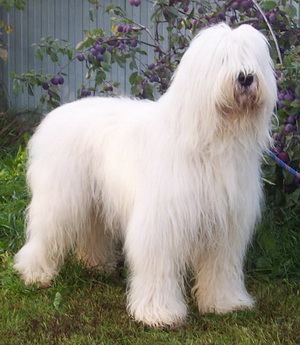
Russia has several breeds of sheepdogs known as ovcharkas, none of which herd sheep, but guard them, and that makes them more like livestock guardian dogs, or LGDs. “Ovcharka” translates to shepherd or sheepdog, but in reality, the word in Russian means something between “livestock guardian dog,” “shepherd’s dog,” and a “sheepdog.”
Confused yet? Just wait. In Russia, “ovcharka” is used as a suffix in the names of many working breeds including those that aren’t native to Russia like the German Shepherd Dog (nemetskaya ovcharka), or, say, the Belgian Sheepdog (bel’giyskaya ovcharka).
Getting back to Russian Ovcharkas. The breeds native to Russia and/or the countries of the former Soviet Union include the Caucasian Ovcharka, the Central Asian Ovcharka (also seen as the Middle Asian Ovcharka), the East European Ovcharka, and the one we’ll be talking about here, the South Russian Ovcharka (SRO), also known as the White Russian.
When flocks of Merino sheep arrived to the steppes of South Russian on the Crimean plains, ancestors of the South Russian Ovcharka came with them. Fabulous herders, these dogs, however, lacked the constitution to endure Russian climate, let alone the steppe wolf. More dangerous than the wolves were the Tartar thieves who targeted property, and poachers who raided the flocks. Needing to “beef up” these otherwise perfect dogs, local shepherds crossbred them with the Komondor, local dogs like the Caucasian Ovcharka and Crimean Greyhound, and some say larger Tatra shepherds, as well. It should be mentioned here that there is a school of thought that believes the breed naturally descended from local shepherding dogs native to Russia and Ukraine.
Whatever its true origins, the shepherds ended up with a large, wicked fast and agile dog that could protect the sheep (move them, if necessary), and guard property. For a long time, most of the breeding of South Russian Ovcharkas was done by the the Falz-Fein family that owned Askania Nova, the largest and most well known “sheep colony” in Russia. By the mid 19th century, the breed was established and even widespread to the extent that according to records, some 2,000 Ovcharkas were permanently working, and a thousand sheep might have four or five dogs watching them.
As versatile as the breed was, however, it fell victim to the times. Farmers moved away from food animal production, the steppe was reclaimed for agriculture, and the dogs became less important. The Russian Revolution nearly destroyed Askania Nova, most of its dogs killed or stolen, and many were shot because they didn’t accept new masters.
What saved the breed from vanishing at that point was the combination of Soviet Union state-run kennels breeding the White Russians for the needs of the Army and police, and the interest of one Professor A. Braunder who in the 1920s, encouraged local breeding programs to help restore the breed. There were even some official Russian entries at a German dog show in 1930, and in 1939, a special exhibition of the breed in Simferopol took place.

Date and location unknown
Sadly, very little could combat the impact of a World War, and breed numbers continued to decline. The numbers of these dogs fell so low that it was felt that to save the South Russian Ovcharka, it would have to be bred with similar breeds. In 1947, the Komondor was once again used to infused new genes, and in the 70’s, another Komondor cross was made. A few new clubs around Moscow sought to bring attention to the SRO in Russia. In 1994, there were 100 “Youzhaks” entered in one Moscow dog show.
Today, the South Russian Ovcharka combines the features of both a livestock guardian and a herding dog, and when the United Kennel Club officially recognized it in 1996, they put it into the Herding Group. The breed is described as more submissive to its owner than a Caucasian or Central Asian Ovcharka, but a South Russian Ovcharka is known to sometimes display aggression towards other animals and people, and that makes the dog not suitable for inexperienced owners.
You might enjoy this video of the breed:
Image found on Pinterest and happily credited upon receipt of information
